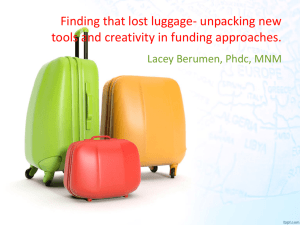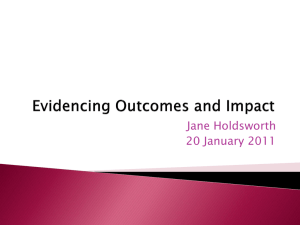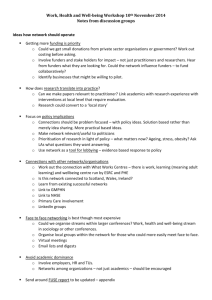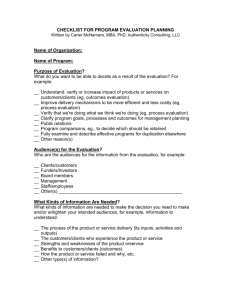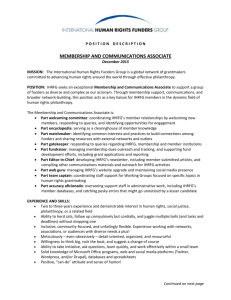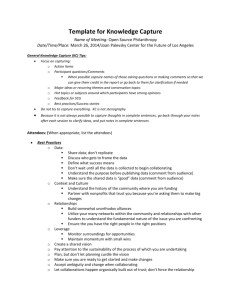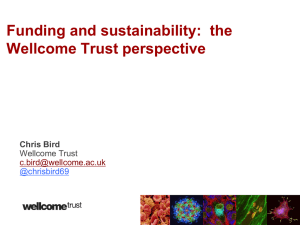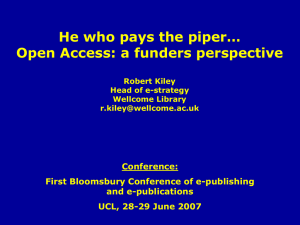Title page plain
advertisement
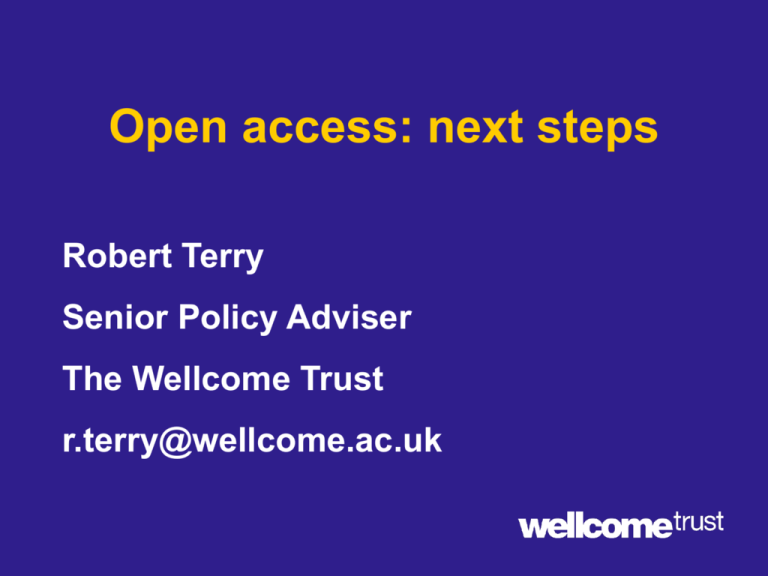
Open access: next steps Robert Terry Senior Policy Adviser The Wellcome Trust r.terry@wellcome.ac.uk Why open access matters to us... Funded by the Wellcome Trust Why should open access publication be important to research funders? • Just funding the research is a job only part done – a fundamental part of their mission is to ensure the widest possible dissemination and unrestricted access to that research. • It’s all about improving access – improving research • Web developments have created a new publishing model - not fully realised whilst access mediated through subscriptions and bundle deals. 90% of NHS-funded research available online full text 30% immediately available to public Only 40% immediately available to NHS staff Submission to the House of Commons Science and Technology Committee's Inquiry into Scientific Publications “How accessible is NHS-funded research to the general public and to the NHS's own researchers? Matthew Cockerill Ph.D., Technical Director, BioMed Central Ltd. http://www.biomedcentral.com/openaccess/inquiry/refersubmission.pdf Shouldn’t those who pay for the research be able to read it? •Over 90% of research funded in UK universities is public money from government, research councils and charities (17%)* *Investing in Innovation - A Strategy for science, engineering and technology – July 2002 DTI http://www.wellcome.ac.uk/publications Why don’t researchers know or care? Publishers £ Profit £ Free Shareholder s & Societies Funders mission? No money for peer review or to author Free £ Libraries £ Gov / ngo funding Two routes to open access – both need to be supported •publish in an open access format •publish in any journal but deposit a copy in an open access repository Publish in an open access format (journal?) • • • • • Immediate global availability Increased usage (citation) improved efficiency Affordable Archived for long term storage and access Long term solution • Few titles but growing • Not as well known – impact but growing • Resistance to the author pays model from authors (passive), learned societies, commercial sector. Will OA publishing cost more? Cost element Proportion of Whole system savings of 30% ? costs 1. Refereeing 22% Estimated costs per article: $2,750 subscription 2. Editorial and typesetting (i.e. from 33% acceptance to first copy) 3. Subscription management 7% 4. Physical production and distribution 23% (including postage) 5. Sales and marketing 13% 6. Promotion to authors 2% Total 100% $1,950 open access Submission fee $175 publication drops to $550 Charges of $10,000++ include contribution of funds to overheads, surplus or profit What will it cost funders? Trust estimates: 1 – 2% of research budget University Press 24% Journals with > 30 papers 1995 - 1999* Elsevier Portland Press CUP Blackwell OUP Nature Society 43% *Source: ROD Commercial 33% Total Trust papers n=16,646 in 1292 journals 10% 5% 5% 4% 4% 3% Publish in any journal but deposit a copy in an open access repository (e.g. UK PMC) Institution and/ or Central (subject based) – both valid but offer users different solutions What do funders want: •Immediate access - but can work with 6 months delay to allow market to adapt. •Long-term digital archive – accurate, future-proof preservation •Searchable – ‘under one roof’ subject based •Build on existing research practice e.g. Medline •Funders attribution, additional features e.g public engagement •Links with other databases e.g. genes, proteins •Strategy, evaluation and impact Portable PMC mirror Source: David Lipman, Director, National Centre for Biotechnology Information, NLM, USA How will UK PMC work Source: David Lipman, Director, National Centre for Biotechnology Information, NLM, USA UKPMC – quality, consistency, adaptability There are three types of errors that PubMed Central deal with: 1. Structural Errors do not conform to the ruleset (DTD) that they were written for e.g. XML tags are wrong: <surname>Jones</snm> 2. Content Errors formula, tables, paragraphs, special characters (Greek characters or symbols) are not correct. 3. Consistency Errors tagged in one style suddenly switches e.g. For the first 5 years of content, Journal X has been tagging dates like: <date>10-12-2004</date> (m-d-y) Then, this date appears in content: <date>14-12-2004</date> (this must be d-m-y) Source: David Lipman, Director, National Centre for Biotechnology Information, NLM, USA Link to imaging agent in PubChem through MeSH Source: David Lipman, Director, National Centre for Biotechnology Information, NLM, USA Links between sequence and related proteins Funder initiatives • Leadership - demonstrate engagement with issues, join with other research funders, raise awareness in research community • Fund - cost of publication (marginal to research costs) • Copyright - encourage author retention use of Creative Commons • Repository - establish open access repositories and selfarchiving UKPMC • Evaluation - recognise intrinsic value of content of paper rather than title of journal • Digitization - of existing titles Dissemination costs are research costs Greater accessibility = greater impact of research The future? • More of the same? – unlikely Increased use of repositories and self-archiving – likely: NIH policy still under discussion Once deposition working, add a Group peer Scottish Science Information Strategy Working review (http://scurl.ac.uk/WG/SSISWGOA/declaration.htm) element - questions the concept of the journal? Further debate in HoC Scientific Publications: Free for all? • More support from funders? - very likely e.g. funders group for UKPMC, Howard Hughes, Max Planck, CNRS, NIH. • Research Councils UK – under discussion…….
